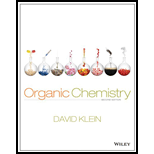
Interpretation:
The
Concept Introduction
Structure of the substrate plays major role in the reactivity of
Leaving group: it is a fragment that leaves substrate with a pair of electrons via heterolytic bond cleavage.
Nucleophile: donates pair of electrons to positively charged substrate resulting in the formation of
Elimination Reaction: It is just reverse reaction of addition where substituent from the given molecule is removed via E1 (the reaction depends only on the substrate involved in the reaction) or E2 (the reaction depends on both of the substituents in the reaction) mechanism.
Systematic Name: It is a standardized name given for a chemical compound in systematic manner. Any organic molecule can be named by using IUPAC (International Union for Pure and applied chemistry) rules. IUPAC name consists of three parts in major namely Prefix suffix and root word.
Prefix represents the substituent present in the molecule. It can be any alkyl group and carboxy, amino, cyano etc…
Suffix represents the substituent present in the molecule. It can be any
Root word represents the longest continuous carbon skeleton present in the organic molecule.
When a molecule consists of cyclic structure, the root word of the molecule is prefixed with cyclo.
Common Name: It is quiet opposite to systematic name which is used for branched groups.
Chirality: It refers to a Carbon atom in a molecule that contains four different substituents.
Enantiomers: they are chiral molecules whose mirror images are not superimposable.
R and S nomenclature: it is used to assign the molecule using CIP rules.
The CIP rules are as follows:
Select the chiral carbon and assign the numbers according to the decreasing
If the numbering follows clockwise direction then the molecule is termed as R and if it follows anti-clockwise direction then molecule is termed as S.
Want to see the full answer?
Check out a sample textbook solution
Chapter 7 Solutions
Organic Chemistry
 ChemistryChemistryISBN:9781305957404Author:Steven S. Zumdahl, Susan A. Zumdahl, Donald J. DeCostePublisher:Cengage Learning
ChemistryChemistryISBN:9781305957404Author:Steven S. Zumdahl, Susan A. Zumdahl, Donald J. DeCostePublisher:Cengage Learning ChemistryChemistryISBN:9781259911156Author:Raymond Chang Dr., Jason Overby ProfessorPublisher:McGraw-Hill Education
ChemistryChemistryISBN:9781259911156Author:Raymond Chang Dr., Jason Overby ProfessorPublisher:McGraw-Hill Education Principles of Instrumental AnalysisChemistryISBN:9781305577213Author:Douglas A. Skoog, F. James Holler, Stanley R. CrouchPublisher:Cengage Learning
Principles of Instrumental AnalysisChemistryISBN:9781305577213Author:Douglas A. Skoog, F. James Holler, Stanley R. CrouchPublisher:Cengage Learning Organic ChemistryChemistryISBN:9780078021558Author:Janice Gorzynski Smith Dr.Publisher:McGraw-Hill Education
Organic ChemistryChemistryISBN:9780078021558Author:Janice Gorzynski Smith Dr.Publisher:McGraw-Hill Education Chemistry: Principles and ReactionsChemistryISBN:9781305079373Author:William L. Masterton, Cecile N. HurleyPublisher:Cengage Learning
Chemistry: Principles and ReactionsChemistryISBN:9781305079373Author:William L. Masterton, Cecile N. HurleyPublisher:Cengage Learning Elementary Principles of Chemical Processes, Bind...ChemistryISBN:9781118431221Author:Richard M. Felder, Ronald W. Rousseau, Lisa G. BullardPublisher:WILEY
Elementary Principles of Chemical Processes, Bind...ChemistryISBN:9781118431221Author:Richard M. Felder, Ronald W. Rousseau, Lisa G. BullardPublisher:WILEY





